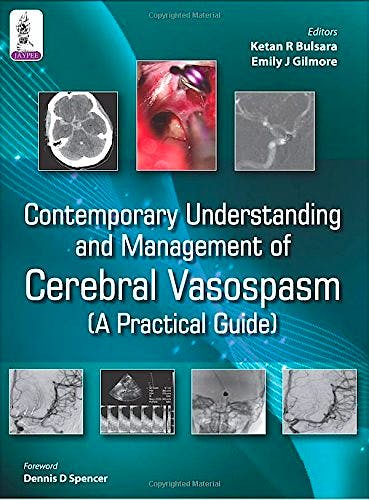

No hay productos en el carrito



Contemporary Understanding and Management of Cerebral Vasospasm. A Practical Guide
Bulsara, K. — Gilmore, E.
1ª Edición Abril 2015
Inglés
Tapa dura
96 pags
707 gr
22 x 29 x 1 cm
ISBN 9789351525608
Editorial JAYPEE
LIBRO IMPRESO
-48%
143,52 €75,00 €IVA incluido
138,00 €72,12 €IVA no incluido
Producto en Liquidación
Description
A walk through any intensive care unit in the world will quickly reveal that although we have made significant strides in the management of subarachnoid hemorrhage, we still have a long way to go. As practitioners, the status quo will never be good enough. The principal challenge, we face in caring for patients after successful endovascular or microsurgical treatment of their culprit lesions is the disheartening devastation caused by delayed cerebral ischemia. It is written by clinicians, for clinicians to provide real-world information based on our current understanding of the disorder with the hope that it will lay the foundation for optimizing treatments across the world. With that goal in mind, we embark upon this journey with you.
This book is meant to support practitioners, who are in the trenches caring for these patients. This book is also meant to serve as a practical resource for all involved in the care of subarachnoid hemorrhage patients.
Key Features
Despite prophylactic measures, multimodality detection monitoring and aggressive treatment interventions, the outcome for many can remain grim. There is no question that the etiologic heterogeneity of cerebral vasospasm mirrors the variability in its clinical management even amongst experienced providers.
Contemporary Understanding and Management of Cerebral Vasospasm: A Practical Guide is written by clinicians, for clinicians to provide real-world information based on our current understanding of the disorder with the hope that it will lay the foundation for optimizing treatments across the world.
Contents
- The History of Cerebral Vasospasm 1
Milo A Hollingworth, Ketan R Bulsara - Definitions and Epidemiology of Vasospasm 4
Hardik Amin, David M Greer - Recent Topics and Advances in the Molecular Mechanisms Contributing to
Cerebral Vasospasm in Subarachnoid Hemorrhage 8
Robert J Claycomb, Kevin N Sheth
Endothelin-1 8; Neuroinflammation and Host Defense 9; Antioxidants and Scavengers of
Free Radicals 10; Tenascin-C and Platelet-Derived Growth Factor 10; Inhibition of HMG-CoA
Reductase 10; Vasodilators 11; Antiepileptic Drugs 11 - The Pathophysiology and Pathology of Cerebral Vasospasm Following Subarachnoid
Hemorrhage 16
David Y Hwang, Anita J Huttner
Anatomic Considerations 16; Morphological Alterations in Cerebral Arteries after Subarachnoid
Hemorrhage 17; Pathophysiology of Vasospasm 17 - Imaging of Vasospasm: The Role of Magnetic Resonance Imaging in Subarachnoid
Hemorrhage-Related Vasospasm 23
Amit Mahajan, Michele H Johnson
Pathophysiology 23; Techniques and Sequences 24; Magnetic Resonance Perfusion
Imaging 24; Limitations of Magnetic Resonance Imaging 26; Hyperacute Magnetic Resonance
Imaging Protocol 27; Role of Magnetic Resonance Imaging in Patients with Subarachnoid
Hemorrhage 27; Perfusion Imaging 30; Vessel Wall Imaging 30 - Imaging of Vasospasm: CT, CTA and CTP Correlated with Digital
Subtracted Angiography in Cerebral Vasospasm 32
Ajay Malhotra, Michele H Johnson
Use of CT, Contrast CT and CTA as Noninvasive Techniques along with TCD and DSA
to Identify Probability, Extent and Severity of Vasospasm 33; Technical Features and
Scan Acquisition 34; Image Interpretation of Computed Tomography Angiography in
Vasospasm 35; Accuracy of Computed Tomography Angiography for Identification and
Stratification of Cerebral Vasospasm 38; Computed Tomography Perfusion in Cerebral
Vasospasm 38; Limitations, Pitfalls and Problems 40 - Imaging of Vasospasm: Transcranial Doppler Ultrasound Imaging: Detecting
Intracerebral Arterial Vasospasm 43
Jonathan D Kirsch, Michele H Johnson, Leslie M Scoutt
Subarachnoid Hemorrhage and Vasospasm Detection 43; Technique 44; Doppler Ultrasound
Physics 45; Biosafety 47; Doppler Evaluation of Vasospasm 48; Other Applications of
Transcranial Doppler Imaging 52 - Medical Management of Vasospasm 55
Evie Marcolini, Emily J Gilmore
Defining the Problem 55; Monitoring and Triggers 55; Triggers for
Intervention 56; Hemodynamic Augmentation 57; Calcium Channel
Blockers 58; Magnesium 58; Endothelin Receptor Antagonists 58; Statins 58;
Nitric Oxide 58; Fever Control 59; Hyponatremia 59; Adrenal Insufficiency 59 - Electroencephalogram Monitoring of Vasospasm 62
Nicolas Gaspard, Emily J Gilmore, Lawrence J Hirsch
Cellular Basis of Electroencephalogram Activity 62; Modifications of Brain Metabolism and
Electroencephalogram Activity Secondary to Ischemia 62; Electroencephalogram Studies in
Patients with Aneurysmal Subarachnoid Hemorrhage 63; Continuous Electroencephalogram
Monitoring for Ischemia Detection 63; Quantitative Electroencephalogram Analysis with the Fast
Fourier Transform 64; Artifacts and the use of Intracortical Electroencephalogram 67;
Other Confounding Factors and the Need for Multimodality Monitoring 67; Continuous
Electroencephalogram for the Monitoring of Treatment 68; Future Developments 68 - Anesthesia for Neurointerventional Surgery 70
Keith J Ruskin
Anesthetic Management 70; Radiation Protection 73 - Practical Microsurgical and Endovascular Treatment of Vasospasm 75
Ryan A Grant, Ketan R Bulsara, Charles C Matouk
Pathogenesis of Cerebral Vasospasm 75; Medical Prevention and Treatment of Cerebral
Vasospasm 76 - Special Populations 85
Lauren A Beslow, Jonathan D Kirsch
A. Pediatric Subarachnoid Hemorrhage 85
Lauren A Beslow
B. Sickle Cell Disease 86
Jonathan D Kirsch
Appendix: Clinical Protocols 89
Subarachnoid Hemorrhage Protocol 89
Vasospasm Protocol 91
Abbreviations 92
Index
© 2025 Axón Librería S.L.
2.149.0